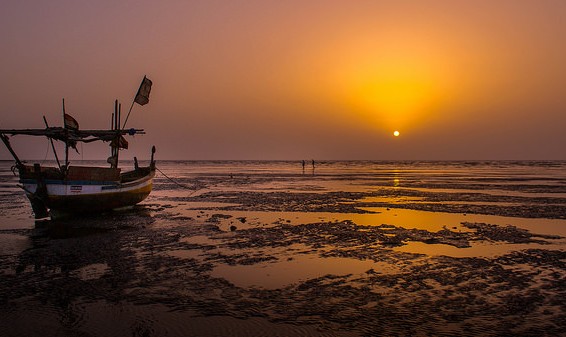Remnants of Portuguese and Parsi history of Daman lie scattered in its churches, chapels, forts and old quarters. I visited Daman with the aim of going off beat into the interiors and exploring the daily life as well as the stories behind its Portuguese history. Here are the list of places I recommend if you are planning to visit Daman –
Portuguese churches & chapels –
They are few in number but still house the original Portuguese wood carving art which is spectacular. With my local friend Gabriel, I first visited the Church of Bom Jesus which is in the main secretariat area of Moti Daman. The altar and pulpits from where the priests give sermons are carved out of wood and are an excellent example of Portuguese wood craftsmanship. ASI (Archaeological Survey of India) frequently does the work of conservation of these wooden panels. The Church of Bom Jesus was started in 1559 but consecrated in 1603. The richly carved main door with elevated façade, lofty ceiling, embellished with the statues of six saints are aesthetic and pleasing.
Chapel of Our Lady of Rosary is set against the very wall of Moti Daman fort. It houses the statue of Mary of Rosary that is said to have been brought from the Dominican monastery of Daman. The walls of main altar are carved in wood showing the daily life of saints and stories from Bible including the last supper.

Moti Daman fort & lighthouse –
Daman is the city of twin forts, each built on the opposite banks of Daman Ganga River at the confluence where the river merges with Arabian Sea. Although the forts are in urgent need of restoration, a walk on the streets inside them gives you an experience of the bygone era. Many original Portuguese buildings are now converted and used as government offices, but their original architecture is still intact. The construction of Moti Daman fort started immediately after the Portuguese conquest of Daman in 1559, and continued till the end of 16th century. The fort is protected by a moat (that is now dry) on southern side and by the river on northern side. The main street that runs from land gate to sea gate has many barracks of defense personnel and a memorial marking liberation of Daman by Maratha light infantry in 1961 resulting in inclusion of Daman in mainland India.
The Portuguese built a lighthouse for their merchant sail ships that used to arrive on the coast of Daman in middle ages. The old lighthouse needs restoration, but a visit to it is worth as it gives a whole spanning view of Moti Daman, Nani Daman and the beach.

Old quarters of Nani Daman –
On my last day in Daman, when I had seen all the forts and churches, I decided to pick up my camera and take a walk in the residential areas. I purposefully ignored the main roads and walked into the narrow lanes near the taxi stand and main market of Nani Daman.
The streets were deserted and peaceful with few children playing around, and sleepy old men and women sitting in their courtyards. Life seemed laid back, lazy and pleasant. Remnants of Portuguese and Parsi buildings lay scattered everywhere. Few were decently maintained by their owners who still lived in them, while many were left abandoned with broken window glasses and a courtyard full of weeds. The houses still had old pastel colours on them in shades of ochre, pink, blue and green that has gradually been chipping off under the influence of sun, rain, and salty sea winds. The red tiled and thatched roofs of these houses were a stark contrast in the foreground of high rise yet ugly modern buildings that have come up in recent years. The ministry of tourism has plans to start a heritage walk in these lanes which might result in restoration of many of these old houses. But that plan seems far from being fulfilled.

Parsi history and fire temple –
I visited one of the Parsi families (Shapur Oliaji, Freny Oliaji and Hormaz Oliaji) for a meal and conversation during my stay in Daman. Parsi community, which is the follower of Zoroastrianism, initially landed at the port of Sanjan, India after their persecution in Persia (ancient Iran) by Muslim invaders in 8th and 10th century AD. They initially settled in Diu. According to Qissa-i-Sanjan, the only official account of Parsi migration and settlement in India, the community was allowed to settle here by the then Hindu ruler Jadi Rana on three conditions – they will speak local language, their women will wear local dress (Saree) and they will not carry any weapons.
Over centuries, the enterprising Parsi community has contributed immensely to the Indian economy. But today they are a minority and dwindling at a fast pace. International movements like ‘Jiyo Parsi’ were launched to encourage more offspring, but have met with little success. Over the conversation table with the head of family, Mr. Shapur Oliaji, we talked about the family’s house that is probably the only house still built in traditional style in this area. About 14 km from Daman is the small town of Udvada with a bit larger Parsi population and one of the most sacred fire temples of India (Udvada Atash Behram).

Featured Image: Nagarjun Kandukuru, Flickr CC
Follow us on Facebook and Twitter
We deliver good food in trains. Download our mobile app from Google Playstore

